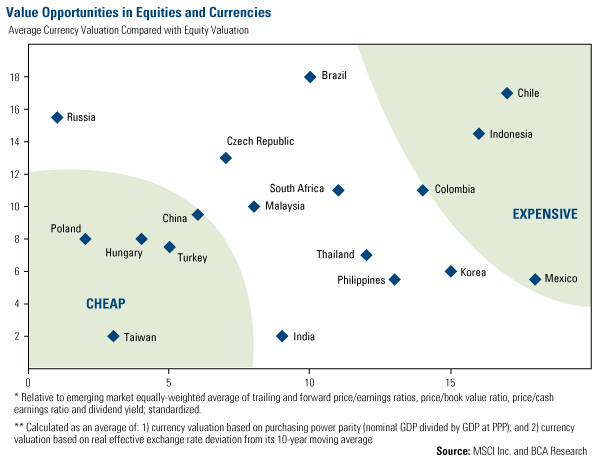Emerging Markets Radar (May 14, 2012)
Strengths
- China’s April Consumer Price Index (CPI) was 3.4 percent, 0.2 percent lower than March but equal to market consensus. This is below the government target of 5 percent, leaving room for further monetary easing if needed.
- Passenger vehicle sales in April were up 13 percent to 1.28 million units, the China Association of Automobile Manufacturers said Wednesday. Sales were forecast to increase 11.3 percent.
- Indonesia’s real GPD rose 6.3 percent for the first quarter, in-line with market expectations. In spite of a slowdown from the previous quarter’s GDP growth of 6.5 percent, the market was satisfied with the outcome considering the headwinds faced by the economies elsewhere.
- Standard & Poor’s stable outlook on Turkey’s long term rating is supported by the agency’s view of the country’s generally effective policymaking and institutions, its moderate and declining public debt burden, and its monetary policy flexibility, said S&P analyst Eileen Zhang.
- Separately, Sam Zell spoke at the annual CFA conference in Chicago. He mentioned that one of his key theses in emerging markets is to invest in a country 3 to 4 years before it attains investment grade, because the process keeps policy makers honest in the run up to the upgrade.
Weaknesses
- Russian electricity distribution companies were denied transition to Regulated Asset Base (RAB) pricing by the Federal Tariff Service, throwing utility sector reform into disarray. The Eastern European Fund has no exposure to Russian utilities.
- Taiwan exports disappointed again in April, falling at a faster pace of 6.4 percent vs. 3.2 percent in March, partly due to holidays in China. China’s April trade number was also weak. China’s exports were up 4.9 percent vs. the estimate of 8.5 percent, while imports were up 0.3 percent vs. the estimate of 10.9 percent.
- China just released April economic data. April industrial production was up 9.3 percent year-over-year, vs. the estimate of 12.2 percent; retail sales were up 14.1 percent, vs. the estimated 15.1 percent; new loans were RMB681.8 billion, vs. the estimate of 780 billion; M2 money supply grew 12.8 percent vs. the estimate of 13.3 percent; and fixed asset investment was up 20.2 percent year-to-date, vs. the estimated 20.5 percent. Due to the weak economic numbers, the market speculation this morning was that the People’s Bank of China (PBOC) will cut the bank reserve ratio tonight.
- The bank of Korea maintained its benchmark rate at 3.25 percent for the 11th successive month as expected, while Indonesia also kept its benchmark rate at 5.75 percent, but raised the central bank rate and term deposits to absorb excessive liquidity.
- Elsewhere in Asia, Malaysia’s industrial production gained only 0.6 percent in March, vs. the estimated 3.3 percent; Philippine export unexpectedly dropped 1.2 percent in March.
- China’s home sales transaction value fell 16 percent in April from the previous month as the government reiterated it will keep curbs on the property market.
Opportunities
- A significant portion of global equity returns comes from the local market currencies effect. The chart below from BCA Research plots country equity valuation along the horizontal axis and proprietary “currency valuation” along the vertical axis. From that perspective, China, Taiwan, and Emerging Europe markets look undervalued, while Indonesia, South Korea, and Latin America look overvalued.

- In April, China’s power production growth was less than 1 percent, one of the lowest monthly numbers. If the past is any guidance, the Chinese equity market will rally following a dismal monthly power generation.

Threats
- One of Russian President Vladimir Putin’s first acts in his new/old job was to sign a directive for the government to implement affordable and comfortable housing. Among the tasks set to be achieved by 2018, the government must bring down the spread between average mortgage rates and inflation to a maximum of 2.2 percent. If implemented as such, net interest margins at the banks would come under pressure.
- Weaker-than-expected April economic numbers strongly suggest the People’s Bank of China needs to cut rates or bank reserve ratio to provide liquidity to the economy.











